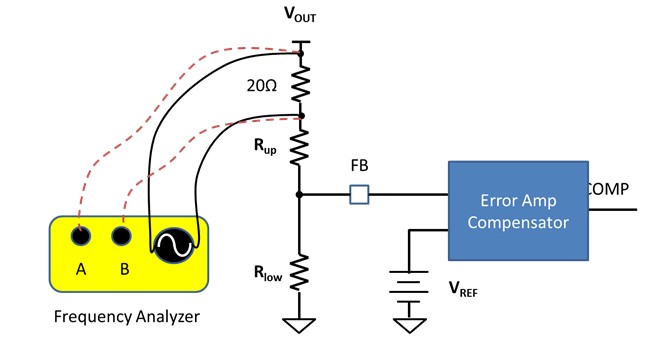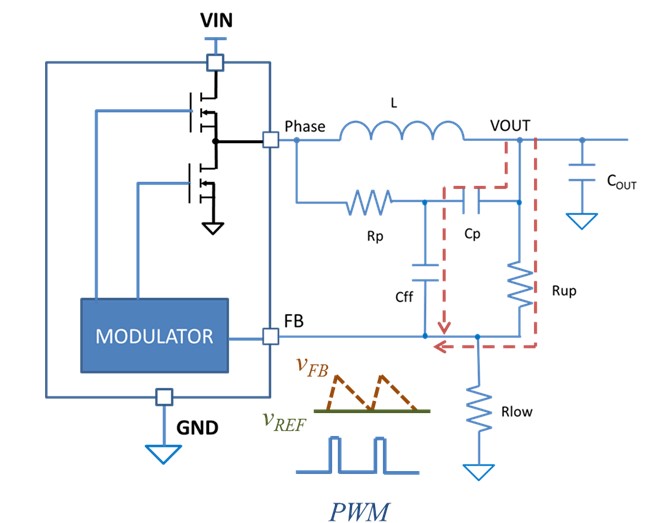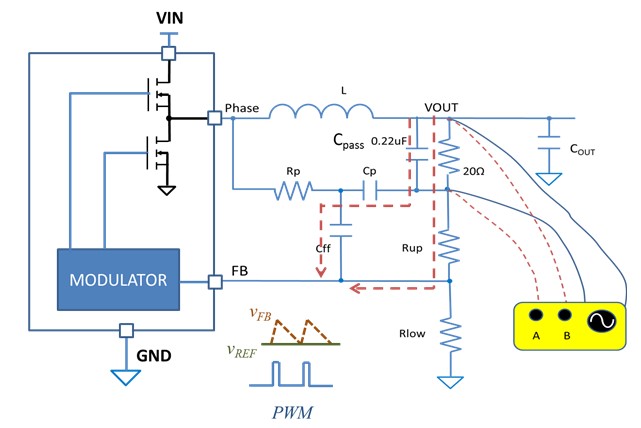SLUAAF4A may 2021 – april 2023 TPS51397A , TPS53318 , TPS53319 , TPS53353 , TPS53355 , TPS548A28 , TPS548A29 , TPS548B22 , TPS548B28 , TPS548D22 , TPS549B22 , TPS549D22 , TPS54J060 , TPS54J061 , TPS54JA20 , TPS54JB20 , TPS566235 , TPS568215 , TPS568230 , TPS56C215 , TPS56C230
1 D-CAP Feedback Loop
DC/DC converters using D-CAP, D-CAP2, and D-CAP3 control architectures, referred to as D-CAPx in this report, became popular for their fast transient response with minimal output capacitance and their simplicity by eliminating external compensation components. The D-CAPx control architecture, a derivative of non-linear constant on-time control, poses a challenge for designers when measuring the control-loop gain. As Figure 1-1 shows, breaking the control loop is the proper technique for traditional linear control architectures, like voltage-mode control and current-mode control, where there is only one output feedback path. But when measuring the control-loop gain for D-CAPx architectures, a different approach is necessary. The D-CAPx control architecture has two direct output feedback paths as shown in Figure 1-2: one through the feedback resistor divider network Rup and Rlow, and the other through the direct current resistance (DCR) injection circuit Rp, Cp, and Cff. The D-CAPx control system does not have a high DC gain error amplifier like the traditional type II or type III compensator of current-mode or voltage-mode control architectures, where the FB pin is usually the negative input of the error amplifier. For D-CAPx converters, the FB pin is only one of the inputs of the PWM comparator. By leaving out one of the feedback path outputs of the measurement, the Bode plot measured using the setup in Figure 1-1 does not directly correlate to the transient response waveforms. To properly measure the loop-gain Bode plot, the loop breaking point must include both feedback paths, as Figure 1-3 shows.
 Figure 1-1 Voltage-Mode or Current-Mode
Control-Loop Gain Setup
Figure 1-1 Voltage-Mode or Current-Mode
Control-Loop Gain Setup Figure 1-2 Block Diagram of a D-CAP
Regulator With an External DCR Injection Circuit
Figure 1-2 Block Diagram of a D-CAP
Regulator With an External DCR Injection Circuit Figure 1-3 Proper D-CAP Regulator
Control-Loop Bode Plot Measurement Setup
Figure 1-3 Proper D-CAP Regulator
Control-Loop Bode Plot Measurement Setup